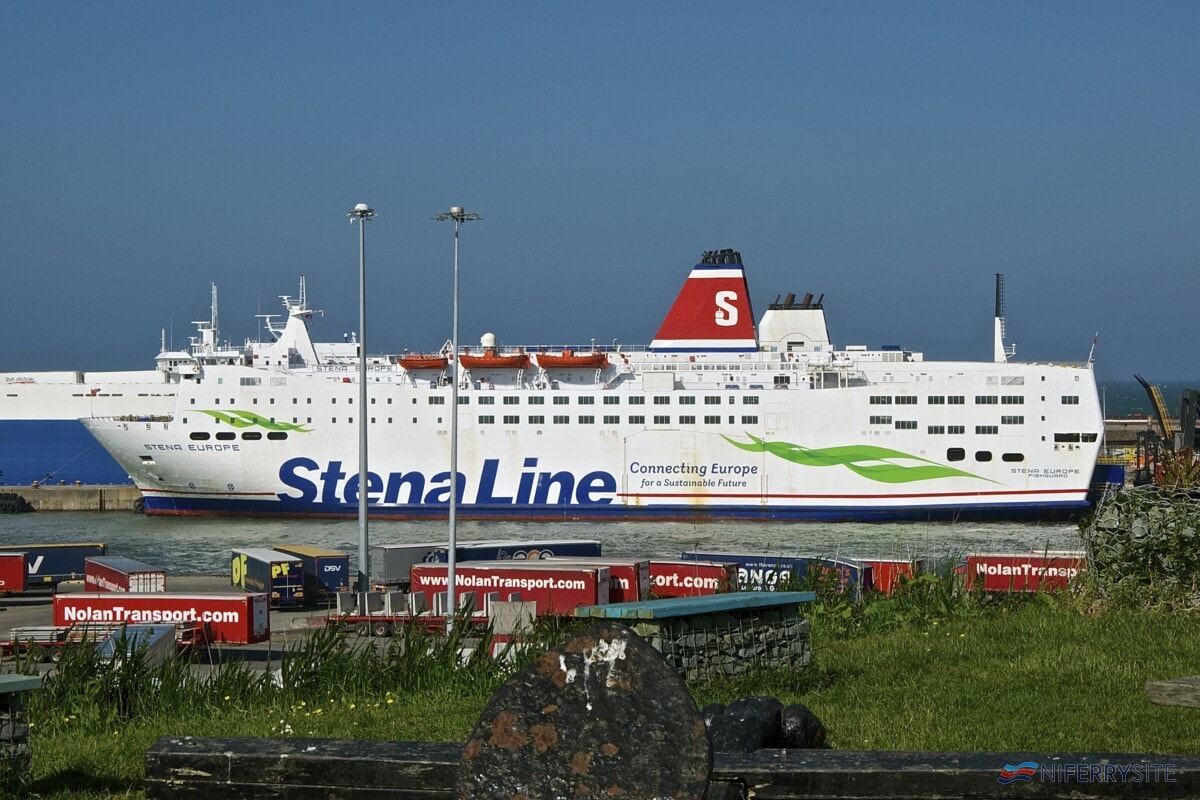Stena Europe’s Early Years
STENA EUROPE was christened as the KRONPRINSESSAN VICTORIA on 1st September 1980 at the Götaverken Arendal shipyard in Sweden. She was christened by H.M Queen Silvia of Sweden, who gave the new ferry the name of her (then) four year old daughter Kronprinsessan (Crown Princess) Victoria. STENA EUROPE and her sister
KRONPRINSESSAN VICTORIA and her sister were ordered by Sessan Line for their Gothenburg to Fredrikshavn service on 15th February 1979 in order to replace much smaller vessels. This was so the company could compete better with Stena Line who also operated the same route. At the time they were set to be not only the largest ferries on their route but also two of the largest ferries in the world!
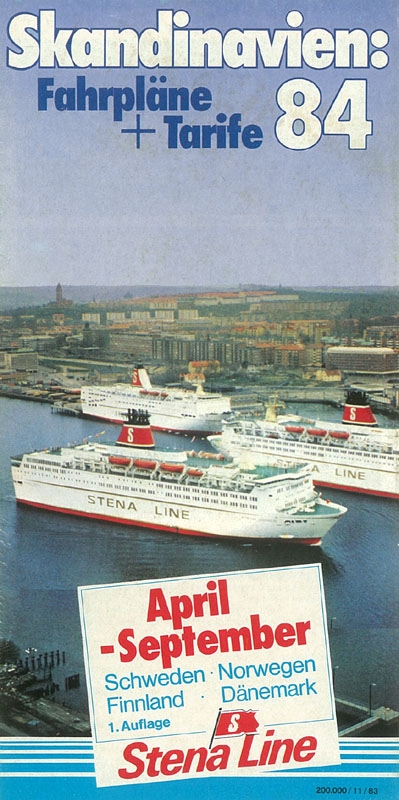
Design
Although built in Sweden, the two new Sessan ships were designed by Sessan in partnership with their long term shipbuilder of choice Aalborg Vaerft A/S in Denmark. Aalborg Værft had expected to build the vessels themselves, but were undercut on price by Götaverken Arendal who were receiving generous Swedish state subsidies. As a result they were able to offer a price of SEK 195m for each ship.
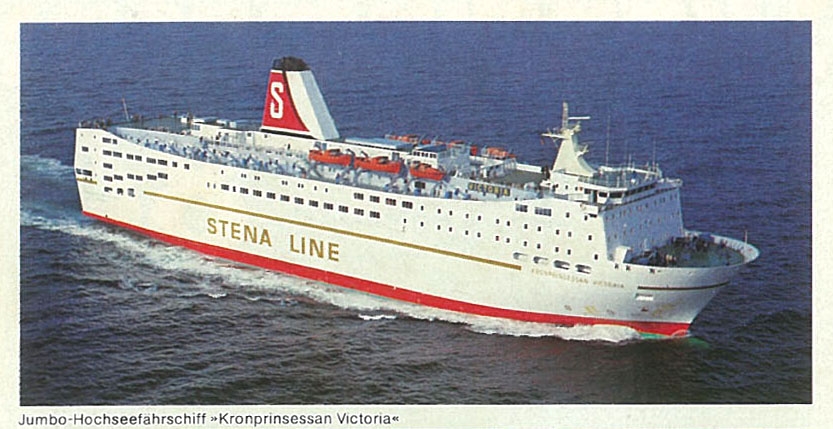
A few months after the official announcement that Sessan Line had ordered the two ferries, Stena responded by placing an order for two large ferries of their own with Chantiers du Nord et de la Mediterrane in Dunkirk, France, for the same route. Unlike the Sessan Line ships, the two Stena Ships (which would become STENA DANICA (4) and STENA JUTLANDICA (2)) where designed by Stena purely as ‘day’ ferries and optimised for the
Compromises for Flexibility
Sessan did not have the financial resources to build new ships for both their Gothenburg – Frederikshavn and Gothenburg – Travemünde routes. Consequently ,the new sisters been designed from the outset to be easily redeployed elsewhere such as the overnight Travemünde service. An example of this was the provision of over 600 cabin berths (over 200 of which were below the freight decks), yet the Fredrikshavn – Gothenburg crossing only took a few hours. Stena
The Sessan Line vessels were also designed to operate from a number of ports independent of port-side ramps and could load and discharge both vehicle decks simultaneously via their three stern ramps. However, at the bow the lower vehicle deck had to be cleared first in order to unload the vehicles on the upper vehicle deck via an internal ramp, with the reverse true when loading.
Sessan Line’s long-term engine supplier NOHAB supplied a new type of engine in cooperation with their now-parent company Wärtsilä, the Wärtsilä-Vasa 12V32. Although these engines produced less power than other engines of similar size they would prove to be extremely reliable, while parts could be interchanged between the main and auxiliary engines which were of similar design.
While KRONPRINSESSAN VICTORIA was still undertaking sea trials during 1981 and months before her delivery, Stena took a majority share in Sessan Line and formed a new company ‘Stena Sessan Line’.
First Rebuild
Unlike her sister, STENA EUROPE has only served with Stena owned companies throughout her career – namely Stena Line/Stena Sessan Line and Lion Ferry. For the first 11 months of that career, almost to the day, KRONPRINSESSAN VICTORIA served the Fredrikshavn – Gothenburg route for which she was built. In March 1982 she entered the dry dock at Gothenburg’s Cityvarvet shipyard for the first of a number of rebuilds, in this case to a night ferry for the Gothenburg to Kiel service, though she also provided extra sailings on the route for which she was built in peak seasons.
Stena Saga
Following the introduction of the second of Stena’s much delayed Polish built night ferries, STENA SCANDINAVICA (since renamed STENA SPIRIT), KRONPRINSESSAN VICTORIA returned to Cityvarvet for even more cabins to be added. This was to make her more suitable for the Oslo –
To Harwich as Stena Europe
By 1994 Stena management had decided that they needed a larger and more luxurious vessel to further grow the Oslo –
As the Harwich – Hook of Holland service didn’t require as many cabins but was a busier route for freight, the decision was taken to remove the additional cabin block which had been added to STENA SAGA‘s top deck in the previous rebuild. This reduced the ships overall weight and so allowed more cargo to be carried. As it was now traditional for the Oslo –
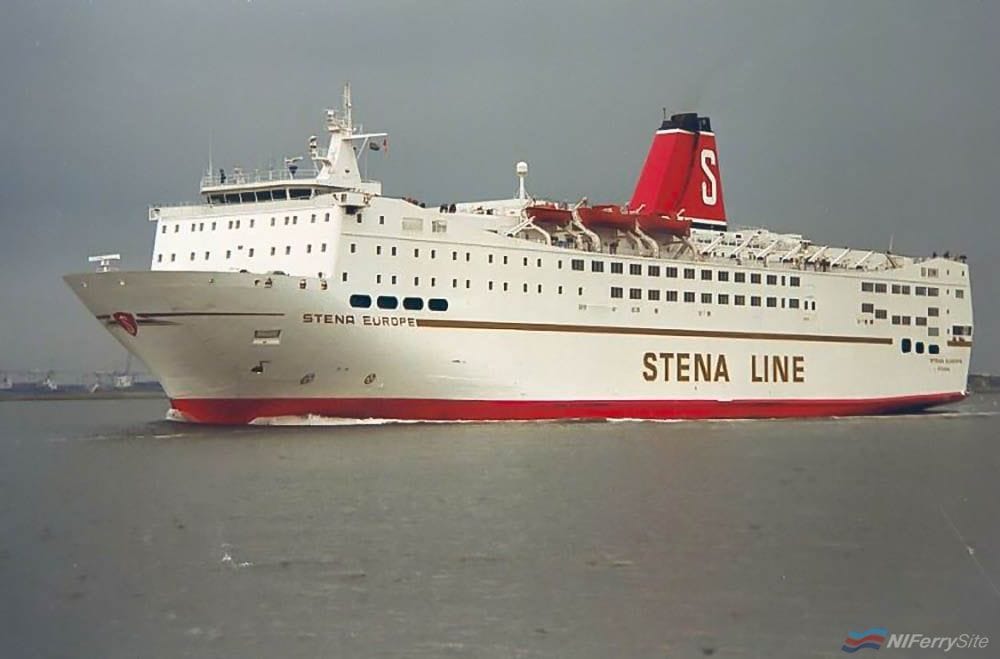
Replacement
STENA EUROPE was a successful ship on the Harwich – Hook of Holland run. This isn’t surprising considering the route had previously been successfully operated by her sister ship ST. NICHOLAS (the former PRINSESSAN BIRIGITTA) before Stena took over the route, which had previously been a joint Dutch (SMZ) and British (Sealink) venture. STENA EUROPE continued on

Lion Europe
KONINGIN BEATRIX went to the Fishguard to Rosslare route to replace another former Scandinavian ferry, STENA FELICITY, which was returned from charter to her owners. Meanwhile, STENA EUROPE was sent for refurbishment and renamed LION EUROPE. She was repainted to operate for Stena’s Lion Ferry subsidiary between Karlskrona (Southern Sweden) and Gdynia. However, during 1998 Stena integrated the Lion Ferry brand fully into Stena Line, and LION EUROPE became STENA EUROPE once again after little more than 6 months!

Back to the UK With a Familiar Name
In 2002 the Karlskrona – Gdynia route was continuing to grow. It was decided yet again to swap STENA EUROPE, this time with her former Harwich to Hook of Holland running mate KONINGIN BEATRIX which would be rebuilt into STENA BALTICA. In order to make her more suitable for the shorter Fishguard to Rosslare route, STENA EUROPE was sent back the same yard that converted her to a night ferry, Cityvarvet Gothenburg, for conversion back to a day ferry. This involved removing cabin accommodation which had been placed on the upper vehicle deck in her previous rebuild and refurbishing the passenger spaces.
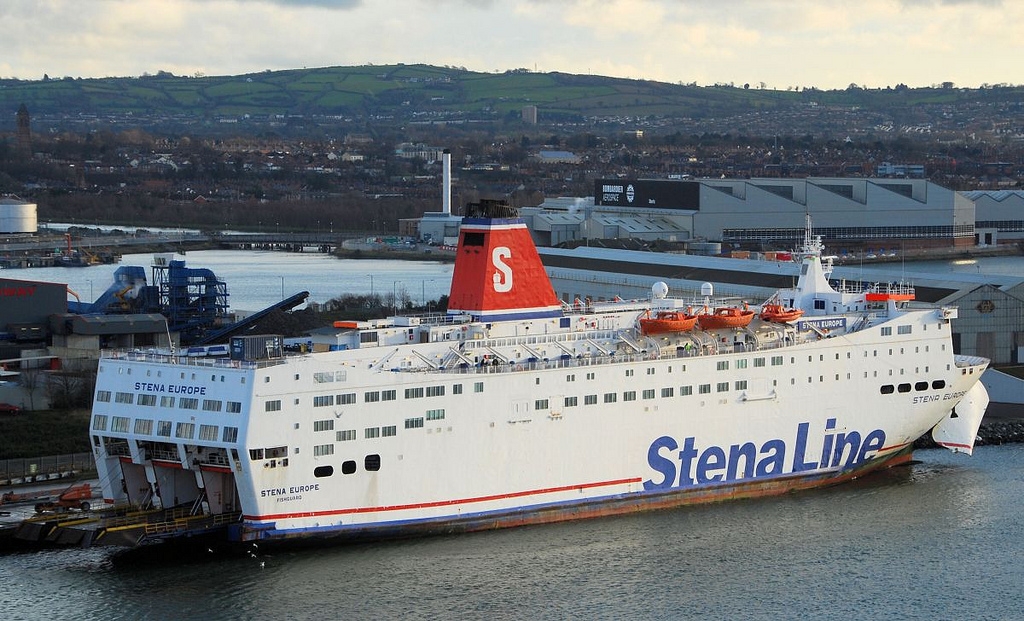
Reunited with Prinsessan Birigita
Apart from periods where she has been required to go for maintenance or cover refit periods, STENA EUROPE has remained on the Fishguard – Rosslare route almost unbroken since 2002. In a further twist, she was reunited with her sister ship

Farewell Sister
NORMANDY was replaced by OSCAR WILDE, and sold on for use as an accommodation ship in 2008 following a brief charter to Ferrymaroc, ending the reunion of the 2 sisters at Rosslare. NORMANDY would never see service again however, as after being renamed ARV2 and abandoned in Singapore for 4 years she was beached at Alang at the end of November 2012. It had been planned by her new owners to convert her into an accommodation vessel. STENA EUROPE, meanwhile, has continued in service and has even outlasted the vessel which replaced her at Harwich, HSS STENA DISCOVERY. The later was scrapped in Turkey during 2015 after an extended period out of service following her sale by Stena in 2009.
Stena Europe and Belfast
During her time operating on the Irish Sea, STENA EUROPE has been quite a regular visitor to Belfast’s Harland and Wolff shipyard. Once significant arrival was on 4th January 2017. During this visit she was modified to accommodate full-height high top “maxi” trailers under the supervision of Stena RoRo. This was achieved by partially removing the existing hoistable car deck above deck 3 (which when lowered becomes deck 4) on the port side, and increasing the deck height at critical points. The result was around 300 lane metres of space for high top trailers.
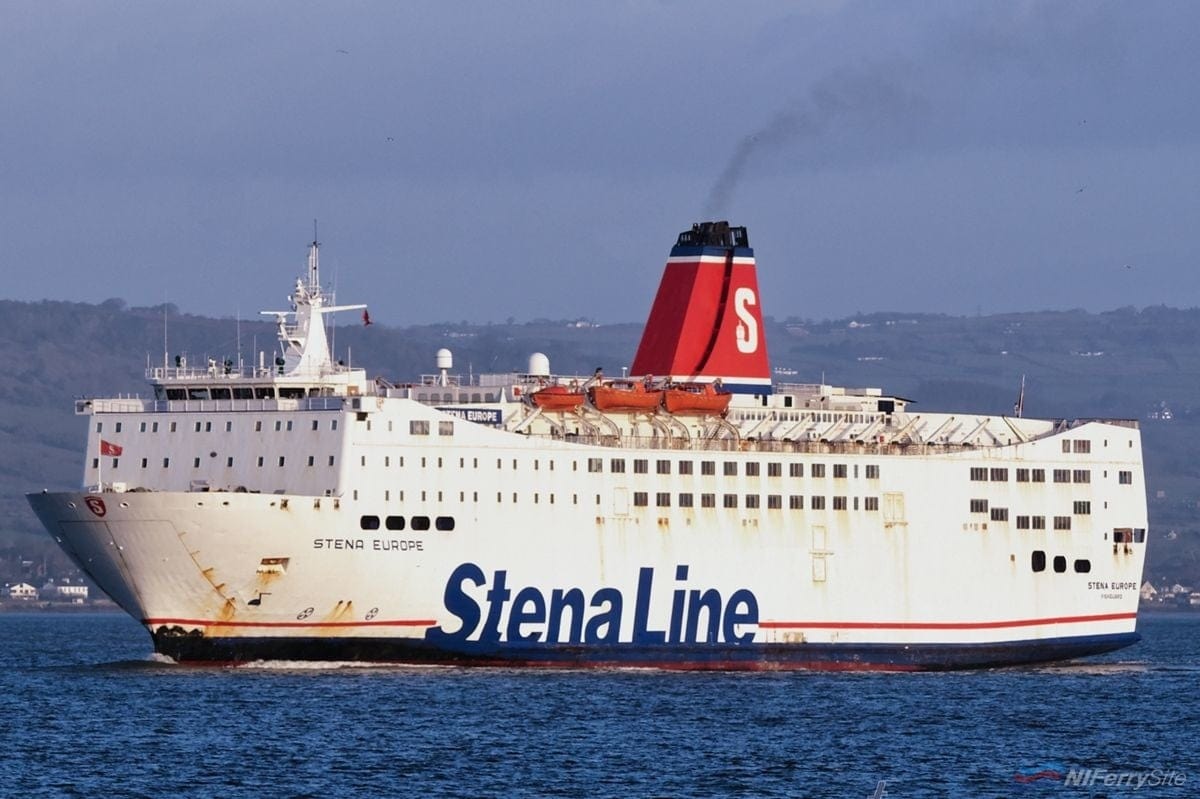
2019 Life Extension
During March 2019 STENA EUROPE arrived at the Gemak Shipyard in Tuzla, Turkey, for life extension work. STENA NORDICA provided cover on the Fishguard route during this time. It had been expected that STENA EUROPE would return to service on Wednesday 26th June, but delays to the project, including some additional work undertaken in Liverpool, meant that she wouldn’t return to service until October 2019. The work being undertook was mostly technical with limited changes made to the passenger accommodation. Stena Line confirmed that changes were made to the deck head on the main deck (deck 3) to allow full-height trailers to be carried across the entire deck rather than just on the port side.
“One of the most significant projects to be undertaken includes modifications to the deckhead levels on the main vehicle deck to allow for the carriage of full-height trailers across the whole of the main vehicle deck. Prior to arrival at the Turkish shipyard, Stena Europe was restricted to carrying full-height trailers on its port side only.
Stena Line statement on the life extension of STENA EUROPE
Other works will include the renewal of the majority of the ship’s windows, engine and hull overhauls including blasting the whole hull to remove all the existing old paint work to improve fuel efficiency and the ships appearance. Internally, the passenger stairwells will be revamped, a redesign of the Barista Coffee outlet, as well as upgrades to the passenger Information Desk and other decor improvements.”
Other modifications which took place included the installation of a modern MES (Marine Evacuation System), and replacement of steelwork and piping. Pictures appeared on Facebook showing the vessel stripped back to bare metal, though these have since been deleted. STENA EUROPE is known to have entered and left dry dock on multiple occasions during her spell in Turkey. She left for Tuzla Anchorage on July 27th, according to some reports for sea trials, but after a while at the anchorage returned to Tuzla.
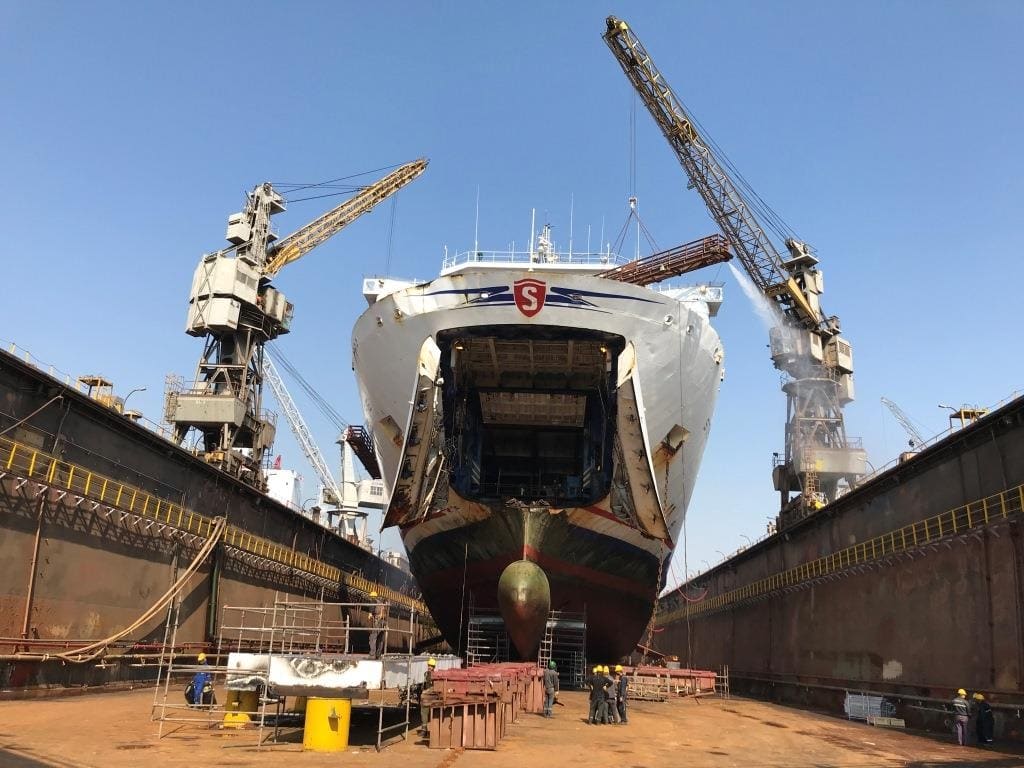
Return to Service following Life Extension
On August 14th 2019 STENA EUROPE appeared on the Stena Line Freight Live Timetable for the first time on September 1st. In a statement, Stena Line blamed unforeseen technical issues and the need to wait for specialist parts for the delay in STENA EUROPE‘s return to service which was originally scheduled during June.
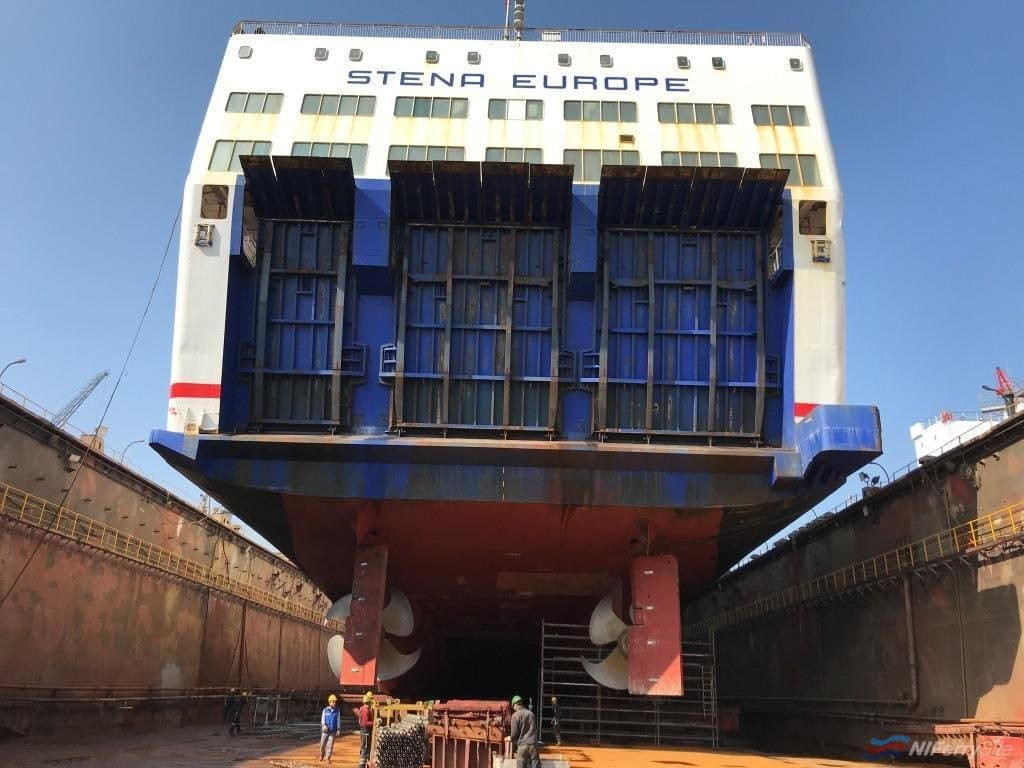
On September 6, STENA EUROPE appeared to undertake sea trials before heading to Istanbul Anchorage. This is understood to have been to collect bunkers. The following day she set sail for Gibraltar with an ETA of September 12th. Despite having reached speeds in excess of 20 kts, on September 8th STENA EUROPE slowed significantly to around 10 kts. Her ETA in Gibraltar was also changed to the morning of September 14th. This reverted back to the 12th the following day, with the vessel having increased speed again.
Having stopped at Gibraltar to take on bunkers on September 12th as originally expected, STENA EUROPE set course for Liverpool. On arrival on Merseyside on September 15th, she entered the lock at Gladstone Dock and made her way to the spare Ro-Ro berth opposite P&O Ferries’ terminal. After some final work was completed and clearance was received from the authorities, STENA EUROPE returned to service on the Fishguard – Rosslare route. Relief vessel STENA NORDICA was released and made her way to Rotterdam for her next assignment.
Life after Stena Line
By the end of 2022, STENA EUROPE was one of the oldest large ferries still in regular service in Northern Europe. Industry information throughout 2022 continued to suggest that STENA EUROPE could be replaced by a rebuilt STENA NORDICA during the following year.
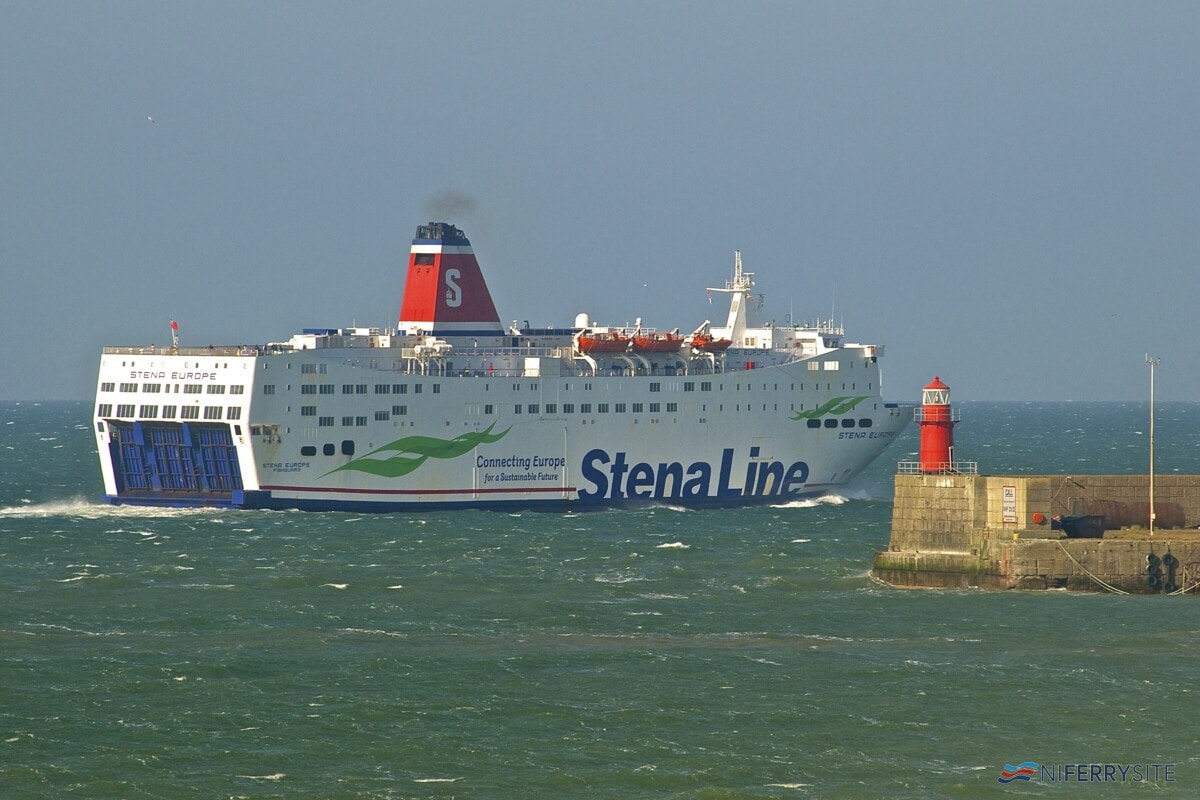
In the final months of 2022, STENA EUROPE was advertised on the Bridgemans Services website as an accommodation vessel under the name “Europe”. This listing was later removed, though industry information at the time was still that STENA NORDICA would replace STENA EUROPE during summer 2023. This would follow rebuilding work on the former ship to make her more suitable for the Fishguard route.
STENA NORDICA arrived in Gdansk for dry-docking on 1 January 2022 having become surplus to requirements on her usual Karlskrona – Gdynia route following the arrival of STENA ESTELLE and STENA EBBA. On 22 February 2023, Stena Line confirmed that STENA NORDICA would replace STENA EUROPE on the Fishguard to Rosslare service during July 2023. Ahead of her prermanent introduction on the Fishguard to Rosslare route, STENA NORDICA provided overhaul cover on the Belfast to Cairnryan route and Stena Line’s North Sea freight services.
Notable Incidents
- On January 30th 2003 STENA EUROPE suffered a failure of all four engines while at sea. The vessel had already been delayed due to weather conditions, with the engine failure happening around 40 minutes into her sailing to Fishguard. The Irish Coastguard activated its emergency plan, however, power was restored to two engines and so the emergency response was stood down. The ship was then diverted to Pembroke rather than Fishguard due to the weather. According to Stena Line this was the first time the vessel ever experienced a breakdown at sea.
- On October 26 2012 there was a minor collision in Rosslare between STENA EUROPE and Irish Ferries OSCAR WILDE in heavy winds. At the time there were 454 passengers and 71 crew on board STENA EUROPE but there were no serious injuries.
- A fire broke out onboard STENA EUROPE while she was approaching Fishguard on the the night of 11 February 2023. This was brought under control and the vessel was brought alongside with tug assistance with 88 passengers plus 59 crew onboard. There were zero casualties. The vessel was able to proceed to a previously planned dry docking at Birkenhead under her own power. In order to carry out repairs to damage caused by the fire the duration of the dry docking was extended.
Stena Europe Technical Data
Unless stated otherwise this data is as the vessel was during 2018 prior to her 2019 life-extension work.
| Name | Stena Europe |
| IMO Number | 7901760 |
| Design | Aalborg Vaerft / Sessan Line |
| Building Yard |
 Gotaverken Arendal, Gothenburg, Sweden |
| Hull Number |
908 |
| Keel laid |
11/02/1980 |
| Launched |
01/09/1980 |
| Completed |
10/04/1981 |
| Classification |
DNV-GL 1A1 Car ferry A Ice(1C) MCDK |
| Conversion – Yard (month/year) |
|
| In service (original) | April 1981 |
| In service (Current route) |
March 2002 |
| Call sign (Present) |
VSTA3 |
| Length overall |
149.02m |
| Beam |
26.53m |
| Draught |
6.14m |
| Gross Tonnage (as built) |
14,378 |
| Gross Tonnage (2018) |
24,828 |
| Machinery |
|
| Power (Max) |
15,360kW |
| Operational design speed |
20 Kts |
| Capacity (As built) |
|
| Capacity (Present) | 1,400 passengers
|
| Vehicle deck configuration |
Twin vehicle decks accessed via 3 stern doors and one bow door. Single level loading and unloading through bow door on main deck, twin level loading via stern ramps. |
| Onboard Facilities in use
|
|
| Flag (Current) |
UK (Fishguard) |
| Former names |
|
Additional photographs
[foogallery id=”20760″]
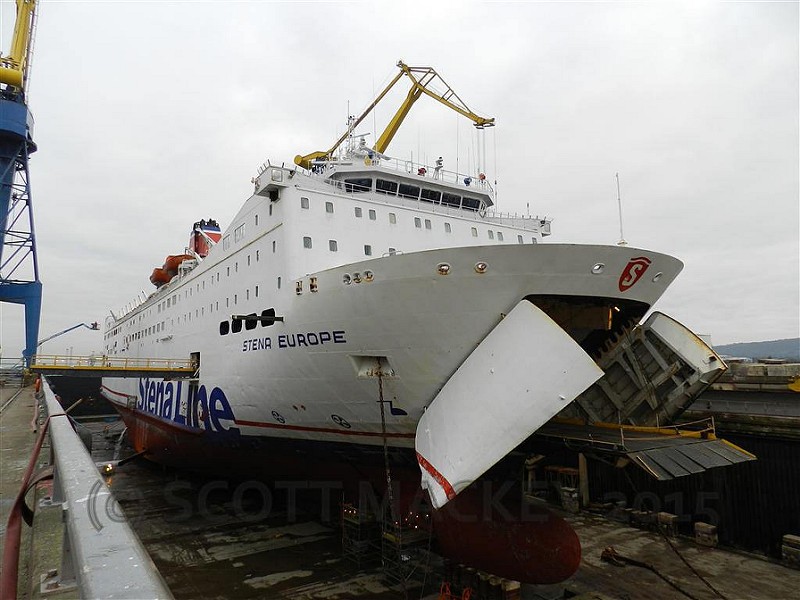

Original Article: 03.01.17
Last Text Update: 09.09.19
